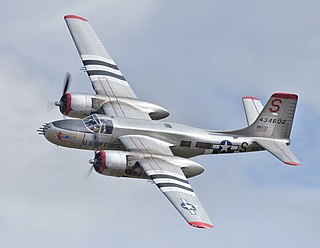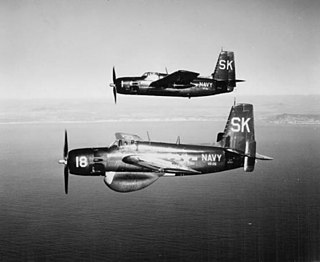 W
WThe Brewster SB2A Buccaneer was a single-engined mid-wing monoplane scout/bomber aircraft built for the Royal Air Force (RAF) and United States Navy between 1942 and 1944. It was also supplied to the United States Army Air Forces and United States Marine Corps.
 W
WThe Brewster SB2A Buccaneer was a single-engined mid-wing monoplane scout/bomber aircraft built for the Royal Air Force (RAF) and United States Navy between 1942 and 1944. It was also supplied to the United States Army Air Forces and United States Marine Corps.
 W
WThe Convair XB-53 was a proposed jet-powered medium bomber aircraft, designed by Convair for the United States Army Air Forces. With a radical tailless, forward-swept wing design, the aircraft appeared futuristic; however, the project was canceled before either of the two prototypes were completed.
 W
WThe Beechcraft XA-38 "Grizzly" was a World War II-era ground attack aircraft, developed by Beechcraft, but never put into production. The Grizzly was to have been fitted with a forward-firing 75 mm cannon, to penetrate heavily armored targets.
 W
WThe Brewster XA-32 was an American attack aircraft, a mid-wing type with an internal bomb bay. The prototype had the R-2800 engine, but it could take the intended R-4360 powerplant. After a dismal set of test results, the XA-32 did not enter production.
 W
WThe Brewster SB2A Buccaneer was a single-engined mid-wing monoplane scout/bomber aircraft built for the Royal Air Force (RAF) and United States Navy between 1942 and 1944. It was also supplied to the United States Army Air Forces and United States Marine Corps.
 W
WThe Curtiss XBTC was an experimental single-seat, single-engine torpedo bomber aircraft developed during World War II.
 W
WThe Douglas A-1 Skyraider is an American single-seat attack aircraft that saw service between the late 1940s and early 1980s. The Skyraider had a remarkably long and successful career; it became a piston-powered, propeller-driven anachronism in the jet age, and was nicknamed "Spad", after the French World War I fighter.
 W
WThe Douglas A-26 Invader is an American twin-engined light bomber and ground attack aircraft. Built by Douglas Aircraft Company during World War II, the Invader also saw service during several major Cold War conflicts. A limited number of highly modified United States Air Force aircraft served in Southeast Asia until 1969. It was a fast aircraft capable of carrying a large bomb load. A range of guns could be fitted to produce a formidable ground-attack aircraft.
 W
WThe Douglas A-33 was an American attack aircraft built in small numbers during World War II. It was an updated version of the Northrop A-17, with a more powerful engine and an increased bomb load. While the A-33 was intended initially for the export market, the entire production run was taken up by the United States Army Air Corps.
 W
WThe Grumman AF Guardian was the first purpose-built anti-submarine warfare (ASW) carrier-based aircraft to enter service with the United States Navy. It consisted of two airframe variants, one for detection gear, the other for weapons. The Guardian remained in service until August 1955, when it was replaced by the twin-engined Grumman S-2 Tracker. The Guardian was the largest single-engine piston-powered carrier aircraft ever to see service.
 W
WThe Martin AM Mauler was a single-seat shipboard attack aircraft built for the United States Navy. Designed during World War II, the Mauler encountered development delays and did not enter service until 1948 in small numbers. The aircraft proved troublesome and remained in frontline service only until 1950, when the Navy switched to the smaller and simpler Douglas AD Skyraider. Maulers remained in reserve squadrons until 1953. A few were built as AM-1Q electronic-warfare aircraft with an additional crewman in the fuselage.
 W
WThe North American Aviation A-27 is an attack version of the North American BC-1. Ten aircraft were ordered by Thailand as NA-69 light attack aircraft.
 W
WThe North American A-36 Apache was the ground-attack/dive bomber version of the North American P-51 Mustang, from which it could be distinguished by the presence of rectangular, slatted dive brakes above and below the wings. A total of 500 A-36 dive bombers served in the Mediterranean and Southeast Asia theaters during World War II before being withdrawn from operational use in 1944.
 W
WThe North American AJ Savage was a carrier-based medium bomber built for the United States Navy by North American Aviation. The aircraft was designed shortly after World War II to carry atomic bombs and this meant that the bomber was the heaviest aircraft thus far designed to operate from an aircraft carrier. It was powered by two piston engines and a turbojet buried in the rear fuselage. The AJ-1 first became operational in 1950 and several were based in South Korea during 1953 as a deterrent against the Communists. Of the 140 built, plus three prototypes, 30 were reconnaissance aircraft. Inflight-refueling equipment was deployed on the Savage in the mid-1950s. The bomber was replaced by the Douglas A3D Skywarrior beginning in 1957.
 W
WThe Vultee A-31 Vengeance was an American dive bomber of World War II, built by Vultee Aircraft. A modified version was designated A-35. The Vengeance was not used operationally by the United States, but was operated as a front-line aircraft by the British Royal Air Force, the Royal Australian Air Force, and the Indian Air Force in Southeast Asia and the Southwest Pacific. The A-31 remained in service with U.S. units until 1945, primarily in a target-tug role.
 W
WThe Vultee XA-41 was originally ordered as a dive bomber. After combat experience led the Army Air Corps to believe dive-bombers were too vulnerable to enemy fighters, the contract was amended to change the role to low-level ground attack. Although the XA-41 was a potent weapons system, the design was overtaken by more advanced technology, and never entered production.